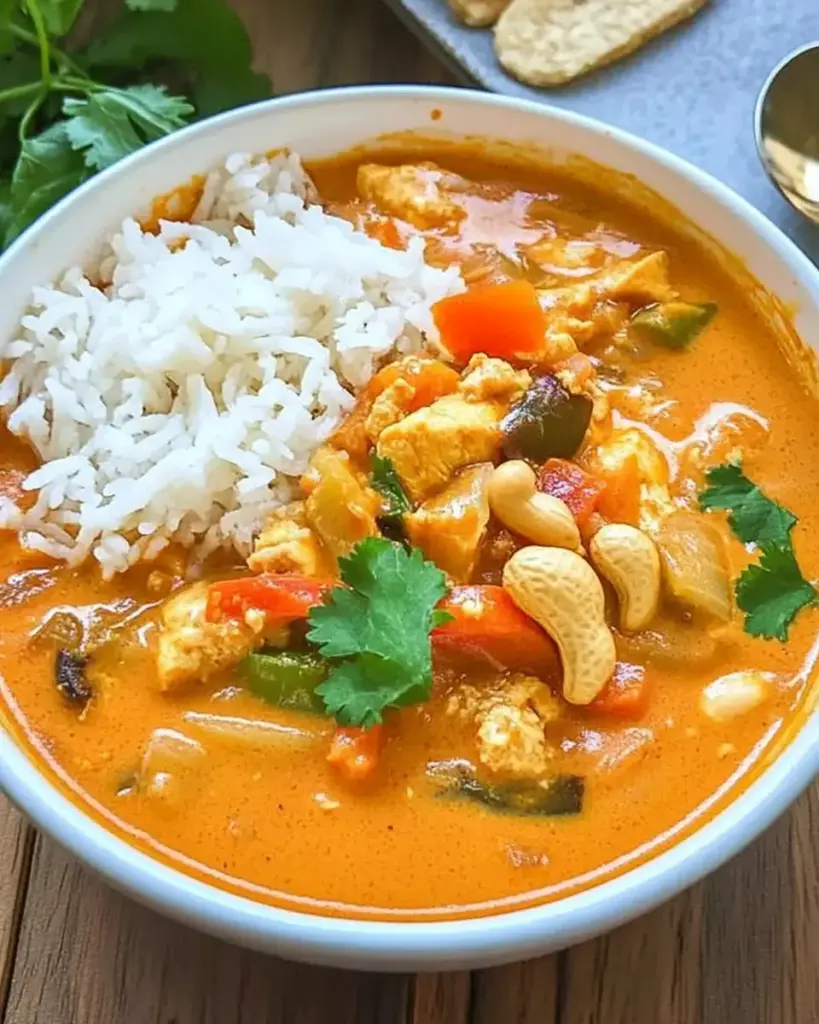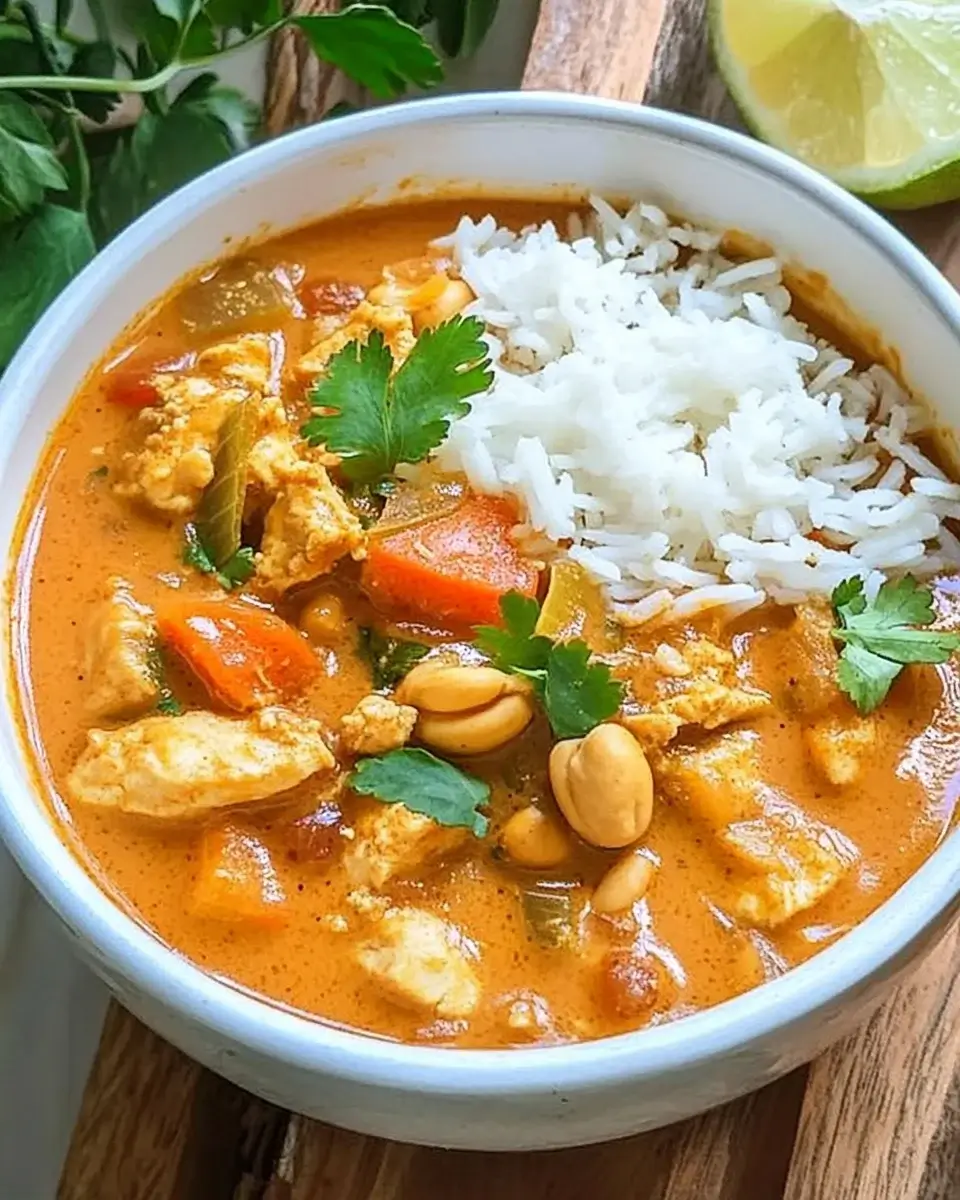Introduction to Thai Peanut Curry
Picture this: it’s a busy weeknight, and you’re staring at the clock, wondering how to whip up something delicious without spending hours in the kitchen. Enter Thai Peanut Curry! This creamy, flavorful dish is not just a meal; it’s a comforting hug in a bowl. With its vibrant colors and rich taste, it’s perfect for impressing your loved ones or simply treating yourself after a long day. Plus, it’s quick and easy to make, so you can savor every bite without the stress. Let’s dive into this delightful recipe that’s sure to become a favorite!
Why You’ll Love This Thai Peanut Curry
This Thai Peanut Curry is a game-changer for your weeknight dinners. It’s not just about the incredible taste; it’s about the ease and speed of preparation. In just 35 minutes, you can create a dish that’s bursting with flavor and nutrition. The creamy coconut milk and rich peanut butter blend beautifully, making every bite a delight. Plus, it’s versatile enough to please even the pickiest eaters in your family!
Ingredients for Thai Peanut Curry
Gathering the right ingredients is the first step to creating a mouthwatering Thai Peanut Curry. Here’s what you’ll need:
- Vegetable oil: This is your base for sautéing. It helps to bring out the flavors of the aromatics.
- Onion: Diced onion adds sweetness and depth to the dish, making it more flavorful.
- Garlic: Minced garlic brings a punch of flavor that’s hard to resist.
- Fresh ginger: Grated ginger adds a warm, spicy note that complements the curry beautifully.
- Red bell pepper: Sliced red bell pepper adds a pop of color and sweetness, balancing the dish.
- Broccoli florets: These add a nice crunch and are packed with nutrients. Feel free to swap them for snap peas or carrots!
- Coconut milk: This creamy base is essential for that rich, velvety texture that makes the curry so comforting.
- Creamy peanut butter: The star of the show! It gives the curry its signature flavor and creaminess.
- Soy sauce: This adds umami and saltiness, enhancing the overall taste.
- Brown sugar: A touch of sweetness balances the flavors and rounds out the dish.
- Red curry paste: This is where you can adjust the spice level. It’s packed with flavor, so use it according to your taste.
- Vegetable broth: This helps to create a lovely sauce consistency. You can use chicken broth if you prefer.
- Lime juice: A splash of lime juice at the end brightens the dish and adds a refreshing zing.
- Salt and pepper: Essential for seasoning to taste.
- Fresh cilantro: This is for garnish, adding a fresh, herbal note that elevates the dish.
- Cooked rice or quinoa: Serve this curry over rice or quinoa for a complete meal.
For those looking to add protein, consider tossing in cooked chicken, tofu, or chickpeas. And remember, you can customize the vegetables based on what you have on hand. The exact quantities for each ingredient are available at the bottom of the article for easy printing!
How to Make Thai Peanut Curry
Now that you have all your ingredients ready, let’s get cooking! Making Thai Peanut Curry is a straightforward process that will fill your kitchen with mouthwatering aromas. Follow these simple steps, and you’ll have a delicious meal in no time.
Step 1: Sauté the Aromatics
Start by heating the vegetable oil in a large skillet or saucepan over medium heat. Once the oil is shimmering, toss in the diced onion. Sauté it for about 3-4 minutes until it becomes translucent. This step is crucial as it builds the foundation of flavor. Next, add the minced garlic and grated ginger. Cook for another 1-2 minutes until fragrant. Trust me, your kitchen will smell heavenly!
Step 2: Add the Vegetables
Now it’s time to bring in the color! Add the sliced red bell pepper and broccoli florets to the skillet. Stir them around and cook for about 5 minutes. You want them to be tender-crisp, so they still have a bit of bite. This not only adds texture but also keeps the veggies vibrant and fresh.
Step 3: Combine the Sauce Ingredients
Pour in the coconut milk, creamy peanut butter, soy sauce, brown sugar, red curry paste, and vegetable broth. Stir everything together until you have a smooth mixture. This is where the magic happens! The peanut butter will melt into the coconut milk, creating a rich and creamy sauce that’s simply irresistible.
Step 4: Simmer the Curry
Bring the mixture to a gentle simmer. This is the time to let the flavors meld together beautifully. Allow it to cook for about 10-15 minutes, stirring occasionally. You’ll notice the sauce thickening slightly, which is exactly what you want. The longer it simmers, the more intense the flavors will become!
Step 5: Finish with Lime Juice
Once your curry has thickened, remove it from the heat. Stir in the lime juice, which adds a bright, zesty finish. Don’t forget to season with salt and pepper to taste. This final touch elevates the dish, making it truly unforgettable. Now, it’s ready to serve!

Tips for Success
- Prep all your ingredients before starting to cook. It makes the process smoother!
- Adjust the spice level by adding more or less red curry paste to suit your taste.
- For a creamier texture, use full-fat coconut milk.
- Don’t skip the lime juice; it brightens the flavors beautifully.
- Experiment with different vegetables based on what’s in season or what you have on hand.
Equipment Needed
- Large skillet or saucepan: A non-stick option works well for easy cleanup.
- Wooden spoon or spatula: Perfect for stirring and mixing ingredients.
- Measuring cups and spoons: Essential for accurate ingredient portions.
- Cutting board and knife: For chopping vegetables with ease.
Variations
- Protein Boost: Add cooked chicken, shrimp, or tofu for a heartier meal.
- Vegetable Swap: Substitute broccoli with snap peas, carrots, or spinach for different textures and flavors.
- Spice it Up: Incorporate sliced jalapeños or a dash of chili flakes for an extra kick.
- Nut-Free Option: Use sunflower seed butter instead of peanut butter for a nut-free alternative.
- Low-Carb Version: Serve over cauliflower rice instead of traditional rice or quinoa for a lighter dish.
Serving Suggestions
- Serve the Thai Peanut Curry over fluffy jasmine rice or quinoa for a hearty meal.
- Pair it with a refreshing cucumber salad to balance the richness of the curry.
- A chilled Thai iced tea complements the flavors beautifully.
- Garnish with extra cilantro and lime wedges for a vibrant presentation.
FAQs about Thai Peanut Curry
As you embark on your culinary adventure with Thai Peanut Curry, you might have a few questions. Here are some common queries that can help you navigate this delicious dish:
Can I make Thai Peanut Curry ahead of time?
Absolutely! This curry actually tastes better the next day as the flavors meld together. Just store it in an airtight container in the fridge and reheat when you’re ready to enjoy.
Is Thai Peanut Curry spicy?
The spice level depends on the amount of red curry paste you use. If you prefer a milder flavor, start with less and adjust to your taste. You can always add more heat later!
Can I freeze Thai Peanut Curry?
Yes, you can freeze it! Just make sure to let it cool completely before transferring it to a freezer-safe container. It can last up to three months in the freezer.
What can I serve with Thai Peanut Curry?
This curry pairs wonderfully with jasmine rice, quinoa, or even cauliflower rice for a low-carb option. A side of fresh cucumber salad or spring rolls can also complement the meal nicely.
Can I customize the vegetables in the curry?
Definitely! Feel free to use any vegetables you have on hand. Snap peas, carrots, or even zucchini work great in this dish. The key is to keep them tender-crisp for the best texture.
Final Thoughts
Cooking Thai Peanut Curry is more than just preparing a meal; it’s about creating a moment of joy in your kitchen. The rich, creamy sauce envelops fresh vegetables, making every bite a delightful experience. Whether you’re sharing it with family or enjoying a quiet night in, this dish brings warmth and comfort. Plus, the ease of preparation means you can focus on what truly matters—savoring the flavors and the company around you. So, roll up your sleeves, embrace the aromas, and let this Thai Peanut Curry become a cherished part of your culinary repertoire!
“`
Thai Peanut Curry: Discover This Delicious Recipe!
Ingredients
Method
- In a large skillet or saucepan, heat the vegetable oil over medium heat. Add the diced onion and sauté until translucent, about 3-4 minutes.
- Stir in the minced garlic and grated ginger, cooking for an additional 1-2 minutes until fragrant.
- Add the sliced red bell pepper and broccoli florets to the skillet. Cook for about 5 minutes, stirring occasionally, until the vegetables are tender-crisp.
- Pour in the coconut milk, peanut butter, soy sauce, brown sugar, red curry paste, and vegetable broth. Stir well to combine all ingredients.
- Bring the mixture to a gentle simmer and let it cook for 10-15 minutes, stirring occasionally, until the sauce thickens slightly.
- Remove from heat and stir in the lime juice. Season with salt and pepper to taste.
- Serve the curry over cooked rice or quinoa, garnished with fresh cilantro.
Notes
- For added protein, consider adding cooked chicken, tofu, or chickpeas to the curry.
- Feel free to customize the vegetables based on what you have on hand, such as snap peas, carrots, or spinach.


